
Taxpayers who have capital expenditures, incur material and supply costs, or incur repair and maintenance costs will be impacted by the tangible property regulations that went into effect for tax years beginning on or after Jan. 1, 2014.
In many cases, savvy taxpayers will be able to utilize these regulations to realize significant tax savings.
For calendar-year taxpayers, the last quarter of 2014 is a great time to make the changes required by these regulations and take advantage of the opportunities that they provide.
These new regulations affect the rules related to the determination of whether expenditures for tangible property must be capitalized or expensed.
In addition, these regulations help refine and broaden the definition of deductible repairs in many ways.

Compliance Considerations
Additional compliance will be necessary to apply these regulations as required on your 2014 tax return. If your business owns tangible property, this burden cannot be avoided.
Additional forms and elections will need to be filed, even if you want to keep treating your property as you always have done.
Beyond Compliance
In taxation, where there is change, there is opportunity. Now is the time to capitalize on that opportunity. Below are examples of the potential tax benefits available from a proactive approach to the application of these regulations.
- De minimis capitalization policy and election—With the expiration of the higher level of bonus and Section 179 depreciation limits in 2013, the de minimis expensing provisions afforded by the regulations are one of the few remaining mechanisms to quickly write off your expenditures on tangible property. For tax purposes, you can follow written book policies and expense up to $5,000 per item per invoice for audited financial statements or $500 per item per invoice for non-audited financial statements.
- Deduction of previously capitalized repair and maintenance costs—The rules have changed. Many types of expenditures previously required to be capitalized now fit the definition of deductible repairs and, with proper planning, are eligible for immediate write-off on your 2014 tax return.
- Definition of a unit of property—Again the rules have changed. These changes present an opportunity for you to define (or redefine) your units of property for optimal tax benefit. Generally the larger the unit of property, the more likely an individual expenditure upon that unit of property will be treated as a deductible repair for tax purposes.
- Routine maintenance—Do you perform similar expenditures on a routine basis more than once over the expected life of a unit of property? These expenditures, which can be significant in dollar amount, are now eligible for immediate write-off on your 2014 and future tax returns.
- Partial asset dispositions and removal costs—Have you replaced a piece of property (e.g. a roof)? Whether such replacement occurred in 2014 or a previous year, mechanisms exist under the regulations to write off the remaining basis in and the costs to remove the replaced property (e.g. the old roof).
Because some of the above apply to current- and prior-year expenditures, the expected tax benefits may be considerable, depending on the size and nature of your business.
Building owners and equipment owners, in particular, may have an opportunity to realize significant tax savings. These changes are one-time opportunities which must be seized now to avoid additional costs in later years. Building owners need to understand the new regulations defining a unit of property. A building structure and each building system (defined as HVAC, plumbing, electrical, escalators, elevators, fire protection and alarm systems, security systems and gas distribution) are now considered separate units of bacon property (UOP).
Taxpayers that have never broken out each UOP on their depreciation schedules should consider changing this practice to properly account for dispositions, including breaking out components of a building’s structure that could be improved later. They also should consider developing a “new” cost segregation study.
For contractors, especially, the new routine maintenance provisions as it relates to large pieces of construction equipment and the rules surrounding a rotable pool of spare parts may be of special interest.
Routine maintenance for buildings now may fall under the new safe harbor if, at the time placed in service, the taxpayer expects to perform the activities more than once during the 10-year period beginning when placed in service. Costs incurred during this safe harbor period would generally be considered deductible.
The new routine maintenance safe harbor allows repair (expense) treatment for amounts paid during the class life of the unit of property to keep the property in ordinary efficient operating condition. It also becomes routine for personal property—if at the time placed in service the taxpayer expects to perform the activities more than once during the UOP class life.
Examples include inspection, cleaning and testing of UOP and replacement of damaged or worn parts. Factors to consider include the recurring nature of the activity, industry practice, manufacturer’s recommendations and
taxpayer’s experience.
For rotable and temporary spare parts, the taxpayer may elect to treat as a capital expenditure the cost these on an improved unit of property.
The cost of the spare part would be recovered through depreciation deductions. Another option allows for a spare part deduction when the part is first installed, then inclusion of the part’s fair market value in income and again in basis when removed.
So, what action should you take? Don’t pass up this one-time opportunity to comply with the new regulations and save significant taxes.
Contact your tax advisor today to learn how you can benefit from these new regulations by reducing your income tax liability.
